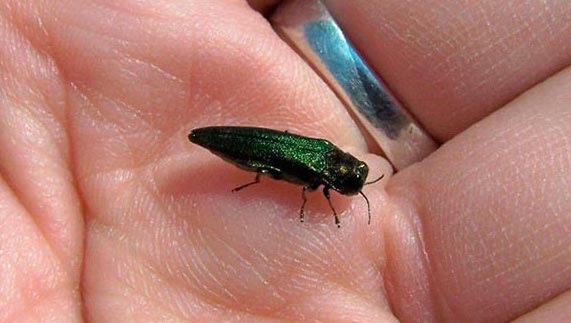Invasive species of beetle discovered on the East End

An invasive species has been discovered on the East End in the Town of Southold.
The emerald ash borer, a beetle native to Asia first discovered in the U.S. in 2002 in southeastern Michigan, was found on private property in Southold last week, according to the Department of Environmental Conservation. The beetle is responsible for the destruction of hundreds of millions of ash trees in the U.S.
“I know of no native ash trees grown that are resistant to the insect,” entomologist Daniel Gilrein, Interim Associate AG Program Director at Cornell Cooperative Extension, said in an email.
The metallic green beetle is very hard to detect in trees during the early stages of infestation, according to the DEC. Mr. Gilrein said it’s unlikely that they’ll be seen until summer months.
The affected trees in Southold were detected after members of the Cornell Cooperative Extension noticed woodpecker activity, Mr. Gilrein said. As birds seek larvae for food, the woodpeckers chipped away the bark on the ash trees and exposed lighter areas of bark. Researchers also found beetle larvae within the inner bark, he said.
Ash trees, more prominent on the South Fork than the North Fork, are not common on Long Island. Most are owned by towns or villages and some are used in some public parks for shade, Mr. Gilrein said.
“This would be a good time for towns, villages, highway departments, parks, arborists and homeowners to assess ash trees present,” he said.
The emerald ash borer typically attacks upper branches and limbs, working its way down to the lower trunk, the entomologist said. Other signs of infestation include branch flagging, or abnormal wilting, outer bark being removed, numerous shoots produced on trunks or limbs and small, D-shaped exit holes in the branches or tree trunks.
Mr. Gilrein said the dead trees could potentially be harmful if they are not removed after they die from infestation. Most trees die within 2 to 4 years of becoming infested.
“Ash trees have a reputation for breaking apart as they die or soon after, and they may become hazardous quickly,” he said. “But ash is not nearly as commonly used on Long Island and is not a common tree in our native woodlands, the EAB population may not develop as quickly or to such a high level as, say, it has done in the Mid-west.”
But there’s hope. There are effective treatments for ash trees that protect them before infestation, Mr. Gilrein said. Landscapers and arborists can apply these treatments.
“Homeowners should contact a professional to discuss their individual situation, to determine whether they have ash trees,” he suggested. “Treat valuable ash trees within about 15 miles of a known infestation.”
Cornell Cooperative Extension encouraged the public to submit suspected samples or contact the diagnostic lab.
Photo Credit: Marianne Prue, Ohio Department of Natural Resources – Division of Forestry, Bugwood.org









